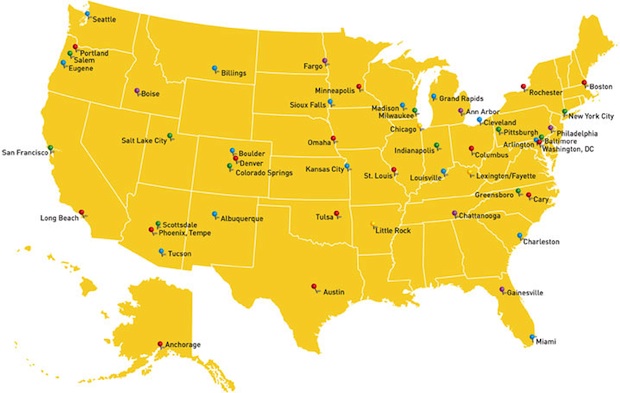 Last month the MIT/Stanford
Venture Lab ran an event at the Stanford Business School, called The
Internet of Things: Sensors Everywhere. The video of the event was
recently put up on YouTube.
We've embedded the entire hour-long video below, along with a 2-minute
video snippet which we think budding entrepreneurs should take note of.
Last month the MIT/Stanford
Venture Lab ran an event at the Stanford Business School, called The
Internet of Things: Sensors Everywhere. The video of the event was
recently put up on YouTube.
We've embedded the entire hour-long video below, along with a 2-minute
video snippet which we think budding entrepreneurs should take note of.
If you have time, the entire event is worth viewing. It delves into current successful use cases for Internet of Things. Panelists include representatives from HP's sensor networks division, a medical software company, and a company which provides sensor-enabled products for vending machines.
innovation DAILY
Here we highlight selected innovation related articles from around the world on a daily basis. These articles related to innovation and funding for innovative companies, and best practices for innovation based economic development.
Belly Button Theory of Innovation
 Unleashing the power of innovation to solve the big social challenges of our time including health care, education, and energy is as simple and plain as our belly buttons. In the spirit of navel gazing I think a lot about how to simplify the innovation narrative, make it more inclusive, and become more experimental. I offer a belly button theory of innovation and its three constructs: one belly button at a time, from innies to outies, and beyond navel gazing.
Unleashing the power of innovation to solve the big social challenges of our time including health care, education, and energy is as simple and plain as our belly buttons. In the spirit of navel gazing I think a lot about how to simplify the innovation narrative, make it more inclusive, and become more experimental. I offer a belly button theory of innovation and its three constructs: one belly button at a time, from innies to outies, and beyond navel gazing.
One Belly Button at a Time
For starters we need a shared definition for innovation. Our rhetoric is all over the place and innovation has become a buzzword. Everything is an innovation and everyone is an innovator and of course when that happens nothing and no one is. We conflate invention with innovation. They are not the same. A simple definition: Innovation is a better way to deliver value. It is not an innovation until value is delivered one belly button at a time. Often we don’t have to invent anything new to deliver value or solve a problem. We have to get better at reconfiguring and recombining existing capabilities and technologies in order to deliver value. We have more technology available to us than we know how to absorb or deploy. It is not technology that gets in the way of innovation it is stubborn humans and organizations that resist change.
Open innovation in regional economies
 A group of us at Purdue, Penn State and The University of Akron are working on new frameworks for open innovation in regional economies. We are developing a network of practitioners at colleges and universities across the country who are positioned to accelerate innovation in regional economies.
A group of us at Purdue, Penn State and The University of Akron are working on new frameworks for open innovation in regional economies. We are developing a network of practitioners at colleges and universities across the country who are positioned to accelerate innovation in regional economies.
Here's a framework that can help regional leaders understand the interplay of investments required to build an innovation economy. With this framework, regional leaders can map their current strategy, as well as evaluate new strategies. From another perspective, this framework specifies the different dimensions of what some are beginning to call an "entrepreneurial ecosystem".
In today's quickly shifting economy of networks, coherence is more important than vision. That's why these visual tools are important. They provide the strategy maps we need to organize both thinking and action in loosely joined networks.
VCJ 20 Most Promising Startups – The Full List
![]() Due to popular demand, we’re making the full list of winners of the
VCJ 20 Most Promising Startups available. See my original post for the genesis of the project and
how we chose the winners.
Due to popular demand, we’re making the full list of winners of the
VCJ 20 Most Promising Startups available. See my original post for the genesis of the project and
how we chose the winners.
Venture Capital Journal subscribers can read in-depth profiles of all the winners here.
Not a subscriber? Go here for subscription and reprint information.
And now—drum roll, please—here are the top 20 most promising startups that raised seed or venture funding in 2009, as chosen by the writers and editors of Venture Capital Journal.
Creating a Portable X-Ray Machine
 A startup company is developing a flat-panel source of x-rays that could help make the imaging technique portable. The company's panels are made using techniques commonplace in the semiconductor industry and would be combined with flat-panel image sensors to make a briefcase-sized x-ray machine powered by a laptop battery. Such a system might be used in the field by the military or instead of bulky bedside systems used in hospital intensive-care units. Early research also suggests it might expose patients to less radiation.
A startup company is developing a flat-panel source of x-rays that could help make the imaging technique portable. The company's panels are made using techniques commonplace in the semiconductor industry and would be combined with flat-panel image sensors to make a briefcase-sized x-ray machine powered by a laptop battery. Such a system might be used in the field by the military or instead of bulky bedside systems used in hospital intensive-care units. Early research also suggests it might expose patients to less radiation.
 The company behind the x-ray source, Radius Health,
was spun out of the University of California, Los Angeles last year. It
is developing a commercial version of a flat-panel x-ray source
developed by physicists at the university. The company will make its
first complete x-ray imager in three to four months and says it will
have a full-scale prototype in a year.
The company behind the x-ray source, Radius Health,
was spun out of the University of California, Los Angeles last year. It
is developing a commercial version of a flat-panel x-ray source
developed by physicists at the university. The company will make its
first complete x-ray imager in three to four months and says it will
have a full-scale prototype in a year.
The x-ray machines used in hospitals today employ a high-energy source of the radiation. A tungsten filament at one end of a long vacuum tube emits electrons when heated and those accelerate down the tube until they hit a metal electrode, causing it to produce x-rays.
Silicon Valley's most seasoned startup CEO
 Dave Duffield is back in a cubicle after building PeopleSoft into a giant, then losing it in a brutal takeover battle with Larry Ellison. How at 70 he's planning his return — and his IPO.
Dave Duffield is back in a cubicle after building PeopleSoft into a giant, then losing it in a brutal takeover battle with Larry Ellison. How at 70 he's planning his return — and his IPO.
 David Duffield has earned a comfortable retirement; over the course
of his nearly 70 years he’s started several companies, helped define
today’s business software market, and become a billionaire. But you
won’t find him on the golf course. Not only is Duffield still a working
stiff, he’s in the Silicon Valley startup game as co-CEO of Workday.
David Duffield has earned a comfortable retirement; over the course
of his nearly 70 years he’s started several companies, helped define
today’s business software market, and become a billionaire. But you
won’t find him on the golf course. Not only is Duffield still a working
stiff, he’s in the Silicon Valley startup game as co-CEO of Workday.
Why would a guy with a billion dollars in the bank still report to his cubicle every morning? (Yes, it's an actual cubicle.) For one thing, he says his latest business idea was just too good to pass up. But mainly, he just seems to love working.
After he lost his last company – human resources software maker PeopleSoft – to Oracle in a brutal takeover battle, it only took a couple of months before he and old buddy Aneel Bhusri began laying the groundwork for another venture. Here’s Workday in a nutshell: It’s the software you need to manage people in a big company, but delivered through a web browser. Think of it as Salesforce.com for employee records.
Managing Multiple Businesses
 Eight years ago, Hamilton Chan faced the daunting task of turning around his father's 30-year-old commercial printing business and shoring up its flagging customer base. Five years later, the Los Angeles company he had grown up working in was back in the black.
Eight years ago, Hamilton Chan faced the daunting task of turning around his father's 30-year-old commercial printing business and shoring up its flagging customer base. Five years later, the Los Angeles company he had grown up working in was back in the black.
So Chan started all over, founding a second company, online stationery seller Paperspring.com. He is CEO of both companies and employs 22, with three individuals working solely for Paperspring and "lots of overlap" among the others.
When is one company just not enough? In Chan's case, the moment arrived when he needed a new challenge.
"When you inherit a legacy business, you're still jonesing to create something of your own," says Chan, a Harvard-educated lawyer and investment banker. "You really learn from past mistakes and you develop experience as an entrepreneur that you'd love to parlay into something that would be ideal—if only you could start from scratch."
Top 7 Myths About Starting A Business
 Starting your own business can be one of the best decisions you ever make in your life. There are many advantages to starting your own business such as independence and control over your potential salary. While all of these benefits are great, there is a lot of misinformation about what it takes to become an entrepreneur. (Find out if you have what it takes in Are You An Entrepreneur?)
Starting your own business can be one of the best decisions you ever make in your life. There are many advantages to starting your own business such as independence and control over your potential salary. While all of these benefits are great, there is a lot of misinformation about what it takes to become an entrepreneur. (Find out if you have what it takes in Are You An Entrepreneur?)
In Pictures: 8
Tips For Starting Your Own Business
Have you ever been told that it takes a lot of money to start a business? Have you ever been told that you need a MBA to start a company? Myths like these keep potential business owners from taking the plunge into entrepreneurship and becoming their own bosses. You may think that you know all of the basics for starting a business but what you believe may in fact be wrong.
Cut Your Job Search Time in Half
I t now takes almost as long to get a job in the U.S. — seven and a half months — as it does to produce your next of kin. That’s the longest slog since the Labor Department began tracking job search duration in 1948. Looked at another way, there are currently an average of six people vying for every job that you are, each of them doing exactly the same things — combing job boards, networking, prepping for interviews — as you. Is there a way to speed up the job search and stand out from your competition?
t now takes almost as long to get a job in the U.S. — seven and a half months — as it does to produce your next of kin. That’s the longest slog since the Labor Department began tracking job search duration in 1948. Looked at another way, there are currently an average of six people vying for every job that you are, each of them doing exactly the same things — combing job boards, networking, prepping for interviews — as you. Is there a way to speed up the job search and stand out from your competition?
Recruiters and other experts say that the only way is to put in the extra work to present yourself so that employers realize they absolutely need you, and that they need you right now.
Mary Berman managed to do it. After interviewing last fall for a job she really wanted in event management and marketing, the 56-year-old Berman decided to ditch the typical thank-you note and instead spent the whole night after the interview creating a detailed action plan for her first 30, 60, and 90 days in the job. She described to her future boss how she would learn the job, build rapport with employees and customers, contribute to the company’s bottom line, and fulfill every function outlined in the job description. And it didn’t hurt that she had already sent the person she first interviewed with, as well as the office receptionist, a chocolate-dipped apple to go with her thank-you note. Three days later, Berman heard back with an offer — just two months after she started her job search.
O Canada! Land of Water Innovation!
![]() American venture capitalists are notoriously fickle water investors.
American venture capitalists are notoriously fickle water investors.
Recognizing that water is a rapidly expanding $400 billion global market, many investors pledge a theoretical interest in water innovations. But in practice, window shopping is the norm. Concerned about the capital intensity of many water projects and the length of water startups' time to market and sales cycles, numerous American venture firms have made only a single water investment. As a result, many firms are not well prepared to evaluate and embrace the next great water startup.
 "If you have done just one, you don't know the 100 different pieces
of the value chain and the market segment," says CMEA Capital's Rachel
Sheinbein, who used to help Intel address wastewater challenges.
"Something else comes in and it is totally different. It is like saying
'energy.' There are so many pieces of [the water market]."
"If you have done just one, you don't know the 100 different pieces
of the value chain and the market segment," says CMEA Capital's Rachel
Sheinbein, who used to help Intel address wastewater challenges.
"Something else comes in and it is totally different. It is like saying
'energy.' There are so many pieces of [the water market]."
North of the border, in Canada, there is a lot less hesitation.
Innovation Far from Silicon Valley
My upcoming book, The
New Polymath due in June, has case studies on Kleiner Perkins,
salesforce.com, Plantronics and plenty of discussions of Google, Apple
and other Valley innovators. But it also showcases plenty of innovation
in places in the rest of the globe.
Here are a few of the many examples across the book (and plenty more in book on Brazil, Israel, S. Korea and 30 more countries):
- Estonia, in a hurry to escape its communist detour, is one of the most “wired” countries in the world. It’s “Tiigrihüppe” (tiger leap) initiative provides a prototype of the digital life citizens in most other countries will achieve in a decade. More than 90% of bank transactions are conducted online. Tallinn (the capital)’s citizens pay for their parking tickets and their bus passes by sending text messages from their mobile phones. They elect their representatives from their home computers. Parliamentary and town hall debates are now recorded without producing any paper trail.
"Tracing a growth path for the creative economy"
 First of all, I would like to thank the Spanish Presidency of the European Union for organizing this important and timely forum.
First of all, I would like to thank the Spanish Presidency of the European Union for organizing this important and timely forum.
I would also like to congratulate the organisers for their decision to invite such a broad array of stakeholders from the cultural sector, business and education.
The cultural and creative industries cut across many social and economic areas, and the broad debate that has animated this forum is a proof of it.
So, it was a good decision to give everyone the opportunity to share their views. It is important for all of us in our different spheres of action to find a way to work together towards shared objectives.
Many issues have been raised over the past two days by the different speakers.
- We’ve heard about access to funding, capacity building, and skills development.
- We’ve heard about the need to open up a common European space to help cultural and creative industries develop locally and go global.
- We’ve heard about initiatives that are aimed to unlock the potential of cultural and creative industries in our countries, regions and cities.
Author: Androulla VASSILIOU, European Commissioner responsible for Education, Culture, Multilingualism and Youth
Download the PDF here.
Work Smart: Freelance Survival Skills

More than 1
out of 10 adult workers are self-employed, and that number tends to go up in a recession. To anyone yoked to a traditional nine-to-five job, the idea of being your own boss and working from home might sound like heaven. The truth is, freelancing isn't easy. After seven years of self-employment, I've found the three biggest challenges 1099ers face are managing time, money, and expectations.
The first question every employee asks when they find out you work
from home is: How do you avoid the distractions of being at home? If no
one's stopping you from wandering into the living room midday to watch Days
of Our Lives, what motivates you to work instead? Freelancers have
to be extra mindful of how they spend their time and set up ways to
transition between home and work mode without a commute. The best way to
switch gears is to create a space dedicated to work and work only.
Ideally this will be a home office with a door on it, but even a
dedicated desk and computer in a corner of a room will do. The key is to
train your brain that when you're in this space, it's time to work.
Managing your money isn't easy when you get the same amount of money in a
steady paycheck every two weeks. But when you're a freelancer, things
get exponentially more complicated. A freelancer is usually in one of
two financial modes: feast or famine. It can be stressful, too. A recent
survey showed that while freelancers are more satisfied with their jobs
than nine-to-fivers, they also shoulder more
financial stress. The survival skill here is to reduce money stress
with a financial safety net, or buffer accounts, that you feed during
feast days and draw on during famine.
The SBIC Program — An Alternative Source of Capital for Private Investment Funds
![]() In this challenging fundraising environment, private equity ("PE") managers have shown increased interest in obtaining capital through the Small Business Investment Company ("SBIC") program, which provides attractive loans to PE firms licensed by the Small Business Administration (the "SBA") for the purpose of financing small businesses.
In this challenging fundraising environment, private equity ("PE") managers have shown increased interest in obtaining capital through the Small Business Investment Company ("SBIC") program, which provides attractive loans to PE firms licensed by the Small Business Administration (the "SBA") for the purpose of financing small businesses.
The SBIC program offers a PE fund access to SBA
leverage, enabling the PE fund to:
- Borrow at rates generally lower than traditional lending sources (September 2009 SBA leverage was priced at just over 4%);[1]
- Increase the size of its fund (to the sum of limited partner ("LP") capital plus SBA leverage);
- Reduce the number of capital calls from LPs (by drawing SBA leverage for interim capital needs); and
- Thereby enhance LP returns.
The February 2009 American Recovery and Investment Act, commonly referred to as the Stimulus Bill, increased the maximum amount of SBA leverage available to an SBIC from approximately $137 million to $150 million (or $225 million for a group of affiliated SBICs). Because an SBIC may generally borrow two (and possibly three) times its committed capital, a $50 million fund may become a $150 million (and possibly $200 million) fund through SBA leverage.
The Fabulous Life Of Dennis Crowley, The Most Wanted Man In Silicon Valley
 Dennis Crowley has it very, very good -- and
we can prove it.
Dennis Crowley has it very, very good -- and
we can prove it.
Dennis is the CEO and cofounder of Foursquare, a mobile "check-in" service that will cross the million user mark faster than Twitter did.
This popularity has led brand name venture capitalists (Khosla, Accel, and Andreessen Horowitz) to prepare to give Foursquare money at a super-high valuation ($80 million? $100 million?).
How To Make Money From Blogging With Chris Brogan
 This question comes up a lot especially amongst small
business owners and entrepreneurs: How do I make money from
blogging?
This question comes up a lot especially amongst small
business owners and entrepreneurs: How do I make money from
blogging?
The bottom line is there are TONS of ways to make money directly and indirectly from your blog including selling a product or service, sponsorships and tasteful (keyword tasteful) advertising (that is what we do), affiliate marketing and many more.
That being said, the most successful blogs aren’t advertisements. They aren’t a bullhorn telling people to buy, buy, buy! The top end of blogs are educational and informative as opposed to hard selling. Meaning they are focused around a topic, not a product.
But let’s not forget the purple elephant in the room for business owners: We want to make money. Money is a good thing.
-- EXAMINE VIDEO FOR INCLUSION --
UMaine forum stresses innovation
 For Maine businesses to thrive, they must innovate. And for the University of Maine System to produce the workers those businesses need, the system must innovate as well.
For Maine businesses to thrive, they must innovate. And for the University of Maine System to produce the workers those businesses need, the system must innovate as well.
That was the message Tuesday from a daylong summit aimed at fostering ideas to match Maine's university programs with the state's economic needs.
"The only strategy is innovation," said Doug Hall, chief executive officer of Eureka! Ranch, a Cincinnati-based think tank that focuses on business innovation. "Innovation means greater survival."
The event, held at the University of Maine in Orono, featured speakers, more than 200 university professors, officials and a handful of representatives from business, health care, government and nonprofits.
Smart Pill Reports Back
 The medicine cabinet of the future could help make sure patients take their medications on time via a myriad of smart technologies. There are already pill bottles that wirelessly report to a computer when a cap has been opened, and devices for automatically dispensing medicine at the right time, and for reminding patients to take their meds.
The medicine cabinet of the future could help make sure patients take their medications on time via a myriad of smart technologies. There are already pill bottles that wirelessly report to a computer when a cap has been opened, and devices for automatically dispensing medicine at the right time, and for reminding patients to take their meds.
 Now researchers at the University of Florida have engineered a smart
pill with a tiny antenna and microchip that could signal when it has
made it into a patient's stomach--reporting to a cell phone or computer
that she has taken her medicine. Their design is the latest of several high-tech pill-reporting efforts to improve
patient adherence and provide accurate reporting.
Now researchers at the University of Florida have engineered a smart
pill with a tiny antenna and microchip that could signal when it has
made it into a patient's stomach--reporting to a cell phone or computer
that she has taken her medicine. Their design is the latest of several high-tech pill-reporting efforts to improve
patient adherence and provide accurate reporting.
The prototype pill is composed of a standard pill capsule, wrapped in a thin label etched in silver nano-ink, comprising an antenna. The team also outfitted the label with a tiny microchip, which can be loaded with sensors to detect measurements like body temperature or pH levels. Both the antenna and microchip communicate with an external transmitter, which researchers say could be fashioned into a wearable device such as a wristband. The transmitter sends low frequency pulses into the body; the pill's antenna tunes into the transmitter's specific frequency, and sends pulses back, along with data collected from the microchip, potentially including the time when the patient ingested the pill, and the type of pill taken.
The Top 50 Bike Friendly Cities in the U.S.

Wondering whether it's a good idea to ride your bike to work? Bicycling Magazine has put together a handy list of the top 50 bike friendly cities in the U.S. (Spoiler alert) Congratulations, Minneapolis, Minn.! Some of the choices are obvious--the list would be suspect if cities like San Francisco, Portland, and New York City weren't included--but others might surprise you. Did you know, for example, that over 5% of Gainesville, Florida, residents commute by bike (it's a town built around the University of Florida, after all)? Or that Fargo, North Dakota, has over 200 miles of bike paths?
All of the cities listed have populations of 100,000 or more, and California kind of got the shaft--Bicycling Magazine aimed for geographic diversity "to avoid having a list dominated by California’s many bike-oriented cities." We would also like to see some kind of ranking--surely some of these cities are superior to others. The list is handy overall, though, and clicking on each city reveals why it was picked. The magazine also has a separate list of the top 5 biking cities with populations of 100,000 of less for claustrophobic riders.
The Best Entrepreneur Bloggers
Rob Go is an associate at Spark Capital, and has a great blog on Tumblr about venture capital and startups. On his blog, he recently asked who are the top entrepreneur bloggers.
Rob and his commenters have some great suggestions, but help us help Rob by telling us who are the best entrepreneur bloggers.
Chris Dixon,
founder of SiteAdvisor and Hunch, serial angel investor, first
personally (Skype!) and now through Founder Collective, is first on
Rob's list, and with good reason. He is a very impressive guy and his
blog is absolutely excellent and must-read.


